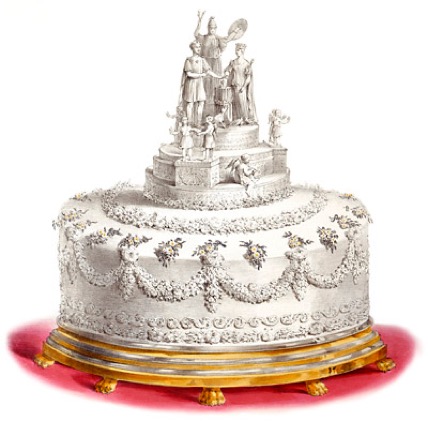Why is it the cake, and not some other element of the wedding celebration, such as announcements, seating, meals, or music, that is generating so much conflict?
As the Supreme Court considers the case of the baker who refused on religious grounds to prepare a cake for a same-sex wedding celebration, this question is telling. Other wedding services may involve creative expression (“expressive conduct”), which would justifiably trouble artists and artisans forced to violate their conscience, but a wedding cake does much more. Although creating a wedding cake requires culinary and artistic skill, the skill is employed to a higher function than simply that of confection or display.
The cake at a wedding is present not primarily to be palatable or visually pleasing—although both these qualities enhance its effectiveness. No, its primary purpose is something different: as an important symbolic artifact, it serves as a focus for well-scripted rituals that signify the nature and purpose of the occasion. And what the cake signifies, to those who know a little cultural history, is nothing less than heterosexual fertility in the body of the bride.
A Cake Unlike Any Other
Start your day with Public Discourse
Sign up and get our daily essays sent straight to your inbox.“The wedding cake,” writes Dr. Simon Charsley in his book Wedding Cakes and Cultural History, “whether ‘traditional’ or in new styles, is no ordinary object.” Its basic function is “marking the event at which it appears as a wedding.” The eminent anthropologist Mary Douglas points out, in her book Food in the Social Order, that a “researcher from Mars” who knew nothing of Anglo-American weddings, “would perhaps be baffled to make up his mind whether the central focus of the ceremony was the marriage or the cake. … the complexity of ritual [of the Kava ceremony in Tonga or the tea ceremony in Japan] would pale into insignificance compared with the ceremonial surrounding the cutting and distribution of the wedding cake.”
As anyone who has ever been to a wedding reception can tell you, the wedding cake follows a recognizable specification. It is usually composed of three matching tiers with white icing, decorated with flowers and topped with an image of the bride and groom. This customary form and style, unlike that of any other cake in common American usage, emphasizes that the cake signals a wedding and nothing else. Douglas observes: “our researcher from Mars will be disappointed if he thinks he can find three-tiered cakes at funerals or Sundays or birthdays. The wedding cake is highly specialized for one social function.” As one hotel manager interviewed by Charsley succinctly put it: “no wedding’s a wedding without a cake.”
The Cake as Bride
The source of this shape, and its signification of fertility, dates back to a very specific event: the 1840 wedding of Queen Victoria. Victoria was famously the first British monarch to wear a white wedding dress to exemplify virginity. She was also the first whose wedding banquet featured a white tiered cake with her own image on top. The huge bottom layer, more than ten feet in circumference and weighing over thirty pounds, served as the base for a pedestal upon which stood three distinct tiers, topped by an elaborately carved scenario of Brittania blessing the Queen and her bridegroom, Prince Albert.
Wedding Cake of Queen Victoria, 1840
(Courtesy of Victoriana Magazine. Public Domain.)
Victoria’s cake immediately became an object of intense publicity, with images featured in the newspapers and crowds of commoners thronging the bakery to see it. “This media frenzy set the standard for all subsequent royal weddings during the Victorian period—and there were quite a number, as all of Victoria and Albert’s nine children married,” writes historian Emily Allen. The royal weddings in turn set the standard for popular culture, so that by the end of the nineteenth century, use of the commercially produced white tiered cake was widespread in both England and America. Queen Victoria had set the pattern for a bride covered in white with a cake covered in white. Together, these two elements have signified female virginity and fertility in Anglo-American weddings ever since.
Today, the Victorian-inspired wedding cake in common use retains its function as a symbolic representation of the bride. Its color and appearance—a white cone-like shape, which is narrow at the top and widens toward the bottom—mirrors the female form of the bride in her white wedding dress, narrow at the top and wide at the bottom.
Cutting the Cake
The central ceremonial event of the wedding reception, as any American who has attended one knows, is the cutting of the cake, followed by the newly married couple sharing the cake first with each other and then with the rest of the guests. Pat and Bill Derraugh’s bestselling book of wedding etiquette provides explicit directions: “The bride holds the knife in her right hand, with the bridegroom’s right hand on hers, and her left hand on top.”
This ritual of cutting and sharing in which the cake, signifying the body of the bride, is pierced by the co-operative action of the man and the woman, expresses the element of fertility and regeneration in a physical, almost graphic, way. In the words of Walter Edwards, analyzing commercialized weddings, the significance of the cake “as a symbol of reproduction and fertility is reinforced by the form of the central act of the cake-cutting ceremony, on which all proceedings fixate: the insertion of the knife . . . a metaphor for coitus . . .” “The cake-cutting ceremony thus symbolically expresses the ideal that husbands and wives should produce children and contributes thereby to the wedding’s coherence as a rite of passage.”
The joint cutting followed by the joint and then communal sharing of the cake ritually enacts the regeneration of human society that is in prospect at every wedding. The natural fertility of the couple, expressed particularly in the penetration of the body of the female (by the joint cutting), generates new life that is rewarding both personally (as they feed each other) and socially (as they feed the assembly). The final act in the cake ritual confirms its expression of fertility even more strongly: preserving the top layer to be shared following the birth of the first child, hopefully by the first wedding anniversary.
It is possible, of course, to reject the meaning of marriage signified by the wedding cake. Charsley writes of one couple who “had ‘discovered’ that the pristine iced cake was the bride herself, and the cutting of the cake, which is a matter of bride and groom jointly forcing a knife into its centre, was the loss of virginity. With such a meaning in mind they felt that they could not possibly go through the ritual,” for reasons of feminism and equality. In a similar vein, and perhaps closer to the point of this essay, Parker and Sedgwick write of homosexual persons [prior to the legal redefinition of marriage] who have “struggled to articulate to [heterosexual] friends or family why we love them, but just don’t want to be at their wedding (emphasis in original),” attesting to “the dynamic of compulsory witness that the marriage ceremony invokes.” Such principled exceptions do not diminish, but rather strongly confirm, the understanding that the wedding celebration rituals, including those of the wedding cake, symbolize meanings that are erotic, female, heterosexual, and procreative for their participants.
Please do not misunderstand me. I do not mean to suggest that the history and significance of the wedding cake related here is widely understood or even known by those involved in most contemporary wedding celebrations. “Wedding cakes and what is done with them are generally entirely taken for granted,” notes Charsley. This does not negate the significance of the cake rituals. All effective ritual signification expresses meaning that is “taken for granted,” that is, assumed without conscious proposition or, usually, disagreement. It focuses, for a moment, part of that diffuse substrate of cultural meaning—what “everyone knows”—which it is the particular competence of sustained anthropological analysis to reveal. The power of such rituals, as with the wedding cake, does not lie in the possibility that everyone understands them or interprets them in exactly the same way, but in the fact that virtually everyone enacts them. Or, more precisely, everyone expects them to be enacted, perpetuating traditions of embedded meaning that, taken together, make up what we understand as culture.
This is manifestly the case in the dispute before the Supreme Court. For in the same-sex couple’s desire for a cake, to the point of offense at being denied one, and in the baker’s considered refusal, at the risk of fines and sanction, to prepare one, both parties acknowledge the fundamental importance of a wedding cake to a wedding celebration. The same-sex couple and the baker may disagree about the marriage, but they apparently agree about the cake.
Inescapable Symbolic Significance
To sum up: Beyond its existence as a work of applied culinary art, the wedding cake is an essential element of a ritual system that expresses the public establishment of a marriage, by means of a form and ritual use that signifies the procreative sexual relationship, with its expectation of fertility in the body of the bride, which is being publicly legitimated by the wedding. In the words of the celebrated food historian William Woys Weaver: “the Great Cake and its layers upon layers of sublimated meanings—erotic to commemorative—are certainly here to stay. It is a food that has become a veritable institution. A wedding without it would be a wedding without protocol, a rite without confirmation.”
Beyond the freedom of artistic expression, it is the incompatibility of this symbolism with the non-heterosexual and non-procreative premise of same-sex marriage, and especially so in the case of the marriage of two men, that is reflected in the conscientiously opposed baker’s objection to preparing and providing a cake. Both the baker and the same-sex couple understand that providing or withholding the cake expresses consent to or dissent from the wedding. The same-sex couple believes that the cake, like their marriage, can express wedding union without heterosexuality. But to the conscientiously opposed baker, who believes marriage to be heterosexual by nature or divine decree, this symbolic severance is not possible. For him, in the attempt to have a wedding without heterosexuality, same-sex couples want to eat their cake and have it too.
This article is adapted from a longer essay.














